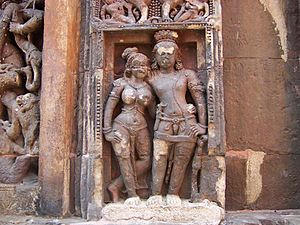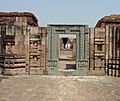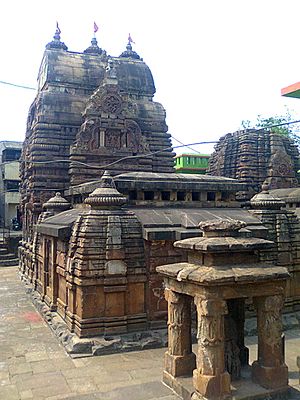Bhauma-Kara dynasty facts for kids
Quick facts for kids
Bhauma-Kara dynasty
|
|||||||||||
|---|---|---|---|---|---|---|---|---|---|---|---|
| c. 8th century CE–c. 10th century CE | |||||||||||
|
<mapframe text="Find spots of the inscriptions issued by the Bhauma-Kara royals (blue) and their feudatories (gray)" width="250" height="250" zoom="6" latitude="20.92" longitude="84.74"> { "type": "FeatureCollection", "features": [ /* Bhauma-Kara vassals: Color 808080 ******************************/ { "type": "Feature", "properties": { "marker-symbol": "monument", "marker-color": "808080", "title": "Aida" }, "geometry": { "type": "Point", "coordinates": [84.6086625, 20.6788414] } }, { "type": "Feature", "properties": { "marker-symbol": "monument", "marker-color": "808080", "title": "Angapada" }, "geometry": { "type": "Point", "coordinates": [84.5595626, 20.9290364] } }, { "type": "Feature", "properties": { "marker-symbol": "monument", "marker-color": "808080", "title": "Antrigam (Antirigam)" }, "geometry": { "type": "Point", "coordinates": [84.8054495, 19.491759] } }, { "type": "Feature", "properties": { "marker-symbol": "monument", "marker-color": "808080", "title": "Bhismagiri (Bishamagiri)" }, "geometry": { "type": "Point", "coordinates": [84.4671424, 19.3925288] } }, { "type": "Feature", "properties": { "marker-symbol": "monument", "marker-color": "808080", "title": "Bonaigarh (Bonai)" }, "geometry": { "type": "Point", "coordinates": [84.951573, 21.820617] } }, { "type": "Feature", "properties": { "marker-symbol": "monument", "marker-color": "808080", "title": "Dashapalla" }, "geometry": { "type": "Point", "coordinates": [84.8489739, 20.3356444] } }, { "type": "Feature", "properties": { "marker-symbol": "monument", "marker-color": "808080", "title": "Dhanantara" }, "geometry": { "type": "Point", "coordinates": [84.6570669, 19.500488] } }, { "type": "Feature", "properties": { "marker-symbol": "monument", "marker-color": "808080", "title": "Goutami (Gautami)" }, "geometry": { "type": "Point", "coordinates": [84.6400645, 19.4095522] } }, { "type": "Feature", "properties": { "marker-symbol": "monument", "marker-color": "808080", "title": "Jayapur" }, "geometry": { "type": "Point", "coordinates": [85.8198244, 20.2106066] } }, { "type": "Feature", "properties": { "marker-symbol": "monument", "marker-color": "808080", "title": "Kharagprasad" }, "geometry": { "type": "Point", "coordinates": [85.3084516, 20.8092359] } }, { "type": "Feature", "properties": { "marker-symbol": "monument", "marker-color": "808080", "title": "Kumarkera (Kumarkela)" }, "geometry": { "type": "Point", "coordinates": [84.593811, 22.1926] } }, { "type": "Feature", "properties": { "marker-symbol": "monument", "marker-color": "808080", "title": "Narasinghpur" }, "geometry": { "type": "Point", "coordinates": [85.0778886, 20.4670003] } }, { "type": "Feature", "properties": { "marker-symbol": "monument", "marker-color": "808080", "title": "Pandiapathara" }, "geometry": { "type": "Point", "coordinates": [84.7080437, 19.6784633] } }, { "type": "Feature", "properties": { "marker-symbol": "monument", "marker-color": "808080", "title": "Puri" }, "geometry": { "type": "Point", "coordinates": [85.8314655, 19.8133822] } }, { "type": "Feature", "properties": { "marker-symbol": "monument", "marker-color": "808080", "title": "Sonepur" }, "geometry": { "type": "Point", "coordinates": [83.8950042, 20.8480141] } }, { "type": "Feature", "properties": { "marker-symbol": "monument", "marker-color": "808080", "title": "Talamulasasan (Talmula)" }, "geometry": { "type": "Point", "coordinates": [85.1868137, 20.7315688] } }, { "type": "Feature", "properties": { "marker-symbol": "monument", "marker-color": "808080", "title": "Tamra" }, "geometry": { "type": "Point", "coordinates": [84.8, 21.9833329] } }, { "type": "Feature", "properties": { "marker-symbol": "monument", "marker-color": "808080", "title": "Tekkali" }, "geometry": { "type": "Point", "coordinates": [84.2301531, 18.6057678] } }, /* Bhauma-Kara royals: Color 000080 *******************************/ { "type": "Feature", "properties": { "marker-symbol": "monument", "marker-color": "000080", "title": "Angul" }, "geometry": { "type": "Point", "coordinates": [85.1510818, 20.8444033] } }, { "type": "Feature", "properties": { "marker-symbol": "monument", "marker-color": "000080", "title": "Boudh" }, "geometry": { "type": "Point", "coordinates": [84.3271305, 20.828446] } }, { "type": "Feature", "properties": { "marker-symbol": "monument", "marker-color": "000080", "title": "Chaurashi (Chaurasi)" }, "geometry": { "type": "Point", "coordinates": [86.1179236, 20.0546442] } }, { "type": "Feature", "properties": { "marker-symbol": "monument", "marker-color": "000080", "title": "Dhanurjayapur" }, "geometry": { "type": "Point", "coordinates": [85.8307059, 21.6289046] } }, { "type": "Feature", "properties": { "marker-symbol": "monument", "marker-color": "000080", "title": "Dharakota" }, "geometry": { "type": "Point", "coordinates": [83.7570955, 19.7280274] } }, { "type": "Feature", "properties": { "marker-symbol": "monument", "marker-color": "000080", "title": "Dhauli Cave" }, "geometry": { "type": "Point", "coordinates": [85.8447846, 20.1881589] } }, { "type": "Feature", "properties": { "marker-symbol": "monument", "marker-color": "000080", "title": "Dhehkanal" }, "geometry": { "type": "Point", "coordinates": [85.4375574, 20.8424388] } }, { "type": "Feature", "properties": { "marker-symbol": "monument", "marker-color": "000080", "title": "Ganesh Gumpha (Udayagiri)" }, "geometry": { "type": "Point", "coordinates": [84.3727004, 20.1172143] } }, { "type": "Feature", "properties": { "marker-symbol": "monument", "marker-color": "000080", "title": "Ganjam" }, "geometry": { "type": "Point", "coordinates": [84.6897495, 19.5859712] } }, { "type": "Feature", "properties": { "marker-symbol": "monument", "marker-color": "000080", "title": "Hindol" }, "geometry": { "type": "Point", "coordinates": [85.2023569, 20.6131143] } }, { "type": "Feature", "properties": { "marker-symbol": "monument", "marker-color": "000080", "title": "Khadipada" }, "geometry": { "type": "Point", "coordinates": [86.4275882, 20.8762757] } }, { "type": "Feature", "properties": { "marker-symbol": "monument", "marker-color": "000080", "title": "Kumurang" }, "geometry": { "type": "Point", "coordinates": [85.1505291, 19.7621557] } }, { "type": "Feature", "properties": { "marker-symbol": "monument", "marker-color": "000080", "title": "Neulpur" }, "geometry": { "type": "Point", "coordinates": [86.1421046, 20.7139076] } }, { "type": "Feature", "properties": { "marker-symbol": "monument", "marker-color": "000080", "title": "Talcher" }, "geometry": { "type": "Point", "coordinates": [85.216816, 20.9501027] } }, { "type": "Feature", "properties": { "marker-symbol": "monument", "marker-color": "000080", "title": "Terundia" }, "geometry": { "type": "Point", "coordinates": [86.0198103, 20.0272072] } } ] } </mapframe> |
|||||||||||
| Capital | Jajpur | ||||||||||
| Religion | Buddhism Hinduism |
||||||||||
| Government | Monarchy | ||||||||||
| Historical era | Classical India | ||||||||||
|
• Established
|
c. 8th century CE | ||||||||||
|
• Disestablished
|
c. 10th century CE | ||||||||||
|
|||||||||||
The Bhauma-Kara dynasty was a powerful kingdom in eastern India. They ruled from the 8th to the 10th century. Their kingdom was called Toshala, and it covered parts of what is now Odisha. The Bhauma-Karas took over land from the Shailodbhava dynasty.
Early Bhauma-Kara rulers followed Buddhism. Later, some rulers followed Shaivism and Vaishnavism, which are branches of Hinduism. This dynasty was special because five of its rulers were women. In the 10th century, other kingdoms like the Bhanjas and Somavamshis took over their lands.
Contents
Who Were the Bhauma-Karas?
The exact start of the Bhauma-Kara family is not fully known. Their earliest records call the family "Bhauma." The name "Kara" was first used later, with the sixth king, Shubhakara II. All the male kings' names ended in "-kara," which might be why "Kara" became part of the family name.
Some historians think the Bhauma-Karas were linked to a tribe called Bhauma. This tribe might have lived near the Mahendra mountain. This idea comes from an old text that mentions "Mahendra Bhauma." However, this theory is not fully proven.
Another idea connects them to the Bhumij or Bhuyan tribes. This is because the names sound similar. But this link is also not very strong. There is no clear proof that these tribes ruled any area before the 10th century.
History of the Bhauma-Karas
Historians use a special calendar era to date the Bhauma-Kara inscriptions. Many believe this era started around 736 CE. This date likely marks the beginning of their rule.
Early Kings and Expansion
The first Bhauma-Kara kings probably ruled the northern part of Toshali. At the same time, the Shailodbhavas ruled the southern Kongoda region. By the time of King Shivakara I (around 756 or 786 CE), the Bhauma-Karas likely controlled most of the coastal area of Odisha.
Shivakara I was a strong ruler. He conquered Kongoda and parts of Kalinga. One record says he even defeated the king of Rarh in present-day West Bengal. He then married the defeated king's daughter.
Challenges from Other Empires
Around 790 CE, Shubhakara I became king. He had to deal with a rebellion from his own relatives. Between 790 and 829 CE, during the reigns of Shubhakara I and his son Shivakara II, the Bhauma kingdom faced many attacks. Powerful empires like the Rashtrakutas and Palas invaded their lands. These invasions made the Bhauma kingdom weaker and caused it to break apart.
Shantikara I, another son of Shubhakara I, married Tribhuvana-Mahadevi I. She was the daughter of the Western Ganga king Rajamalla. Her records suggest that her father helped end the Rashtrakuta-Pala control over the Bhauma-Kara kingdom. She managed to bring the kingdom back together. However, it probably never became as powerful as it once was. She later gave up her throne when her grandson, Shantikara II, grew up.
Troubles Within the Family
Around 880 CE, the Bhauma-Kara family started having serious internal problems. This led to their slow downfall. Shubhakara IV, the first king known to follow Shaivism, ruled for less than five years. His brother, Shivakara III, ruled for about nine years after him.
Then, Tribhuvana-Mahadevi II, who was Shubhakara IV's queen, took the throne around 894 CE. Her records incorrectly claimed that Shivakara III died without an heir. This was likely a way to ignore the claims of her nephews to the throne. Many historians believe she became queen with help from her father, Janmejaya I. He was a ruler of the nearby Somavamshi dynasty.
Her rule was probably very short. There might have been disagreements among the court officials about her becoming queen. Later Bhauma-Kara kings did not mention her reign. This suggests that Shivakara III's sons did not see her as a rightful ruler. They might have even set up their own governments at the same time.
Between 894 and 923 CE, at least five different rulers claimed the Bhauma-Kara throne. This shows how unstable the kingdom had become. After Tribhuvana-Mahadevi II, two of her nephews, Shantikara III and Shubhakara V, ruled. Then, Gauri-Mahadevi, Shubhakara V's queen, took control. She likely ruled as a regent for her young daughter, Dandi-Mahadevi.
After Dandi, her stepmother, Vakula-Mahadevi (another queen of Shubhakara V), became queen. Her family might have helped her remove Dandi from the throne. After Vakula, Dharma-Mahadevi, a queen of Shantikara III, ruled. These queens used important royal titles, showing their power.
The neighboring Somavamshi and Bhanja dynasties tried to take over the Bhauma-Kara kingdom. This led to many disagreements and political tricks. Eventually, the Bhauma-Kara territory came under the control of the Somavamshi dynasty.
Where They Ruled
The Bhauma-Kara kingdom was known as Toshala. This name probably came from Toshali, an old capital of Kalinga. Their land records show that their kingdom included a large part of Odisha. It also included the Midnapore district of West Bengal. Some parts of their land were managed by local rulers who had some independence.
The Bhauma-Kara period was important because it started to bring together different historical regions. These included Odra, Toshala, Kongoda, and Utkala. The kingdom was divided into smaller areas for easier management. These areas were called mandalas (revenue divisions), vishayas (districts), khandas (sub-divisions), and villages (Patakas, Patikas, and gramas).
Their capital city was Guhadevapataka. Today, this place is identified as Gohiratikar in the Jajpur district. It might have been a new name for an older city called Viraja, or a new city built nearby. Later, the Somavamshi rulers moved their capital to Guheshvarapataka and renamed it Abhinava-Yayatinagara.
Religion and Culture
The Bhauma-Kara kings were open-minded about different religions. They supported both Buddhism and Shaivism (a branch of Hinduism). For example, Shubhakara I was a Buddhist, but his queen, Madhava-devi, was a Shaivite. Shubhakara III, also a Buddhist, gave land to a shrine dedicated to Shiva. Shivakara III, a Shaivite, gave land to a Buddhist temple.
The Dhenkanal inscription of Tribhuvana-Mahadevi I says that her ancestors, Shivakara I and Shantikara I, spent a lot of money on religious projects. They built many temples and monasteries to help their country.
Buddhism
The first three kings of the dynasty, Keshmankara, Shivakara I, and Shubhakara I, were all Buddhists. Some later kings, like Shivakara II and Shubhakara III, were also Buddhists. The Bhauma-Karas helped make Ratnagiri a very important Buddhist center. Other important Buddhist sites like Lalitagiri, Pushpagiri, and Udayagiri were also in their territory. During their rule, Buddhism in the region slowly changed from Mahayana to Vajrayana.
Chinese records mention that a former king from the Odra country, Shubhakara-simha, visited China in 716 CE. He brought many Buddhist texts and helped spread Vajrayana Buddhism there. This Shubhakara-simha might have been an ancestor of the Bhauma-Kara kings.
In 795 CE, the Chinese emperor received a special Buddhist text from the king of Odra. This king was likely Shivakara I or his son Shubhakara I. In the 9th century, a famous Buddhist monk named Prajna lived in a monastery in Odra. This shows that Buddhist monasteries in Odra were well-known around the world.
Hinduism
Later in the Bhauma-Kara rule, Brahmanism (Hinduism) became more popular in Odisha. This might have been because the rulers wanted to control some unusual practices happening in the name of Tantric Buddhism. Madhava-devi, the queen of Shubhakara I, built a temple for Shiva. She also appointed a religious leader to perform worship there.
Queen Tribhuvana-Mahadevi I (around 846 CE) was a Vaishnavite (a follower of Vishnu). Her father helped remove invaders from the kingdom.
The tenth king, Shubhakara IV (around 881 CE), was the first Bhauma-Kara ruler to call himself a devotee of Shiva. All the kings after him were Shaivites. Most of the temples built by the family were dedicated to Shiva. The only known exception is the Vaitala Deula temple, which is dedicated to the goddess Chamunda.
List of Rulers
We know about the Bhauma-Kara rulers from their copper-plate inscriptions. These inscriptions give dates in their own calendar system. They also match dates from other dynasties, like the Somavamshis. Here is a list of the Bhauma rulers with their approximate ruling dates (in CE), assuming their calendar started in 736 CE.
| Name (IAST in bracket) | Known dates | Spouse | Note |
|---|---|---|---|
| Kshemankara-deva (Kṣemaṃkaradeva) a.k.a. Lakshmikara | c. 736 | Vatsa-devi | |
| Shivakara-deva I (Śivakaradeva) a.k.a. Unmattasimha a.k.a. Unmattakeshari | c. 756 or 786 | Jayavali-devi (daughter of king of Radha) | Son of Kshemankara |
| Shubhakara-deva I (Śubhākaradeva) | c. 790? | Madhava-devi | Son of Shivakara I |
| Shivakara-deva II | c. 809? | Mohini-devi | Son of Shubhakara I |
| Shantikara-deva I (Śāntikaradeva) a.k.a. Lalitahara I / Lalitabhara a.k.a. Gayada I | Tribhuvana-Mahadevi I | Son of Shubhakara I | |
| Shubhakara-deva II | c. 836 | Son of Shivakara II | |
| Shubhakara-deva III a.k.a. Kusumahara I / Kusumabhara a.k.a. Simhaketu | c. 839 | Son of Shantikara I and Tribhuvana-Mahadevi I | |
| Tribhuvana-Mahādevī I | c. 846 | Shantikara I | Daughter of Western Ganga king Rajamalla, Mother of Shubhakara III |
| Shantikara-deva II a.k.a. Lavanabhara I / Lonabhara a.k.a. Gayada II | Hira-Mahadevi (daughter of Simhamana) | Son of Shubhakara III | |
| Shubhakara-deva IV a.k.a. Kusumahara II | c. 881-884 | Prithvi-Mahadevi Tribhuvana-Mahadevi II | Son of Shantikara III |
| Shivakara-deva III a.k.a. Lalitahara II | c. 885 | Son of Shantikara III | |
| Tribhuvana-Mahadevī II | c. 890 | Shubhakara IV | Daughter of Somavamshi king Janmejaya I |
| Tribhuvana-Mahadevī III | c. 896 | Shivakara III | |
| Shantikara-deva III (Śāntikaradeva) a.k.a. Lavanabhara II / Lonabhara II | Dharma-Mahadevi | Son of Shivakara III, Nephew of Tribhuvana-Mahadevi II | |
| Shubhakara-deva V | Gauri-Mahadevi and Vakula-Mahadevi | Son of Shivakara III | |
| Gaurī-Mahadevī | Shubhakara V | Probably a regent for her daughter Dandi | |
| Daṇḍi-Mahadevī | c. 916 or 923 | Daughter of Shubhakara V and Gauri | |
| Vakula-Mahadevī | Shubhakara V | Daughter of a Bhanja king, Step-mother of Dandi | |
| Dharma-Mahadevī | Shantikara III |







